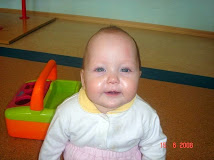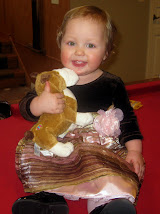Since we are adopting a toddler, the book “Toddler Adoption: The Weaver’s Craft” came highly recommended. Honestly, I know it has lots of good and valuable information, but all the worst case scenarios were just too much for me to take. I started reading it in May 2007 and have yet to finish it. However, I found an article posted on “Sole of Adoption” that condenses the basic information from The Weaver’s Craft into an easy to understand concept that I can apply to life with our newly adopted child. Here it is:
Attachment in International Adoption
[January 29th, 2007 - This post was written by Devora under General, Adoptive & Foster Parenting, From Guatemala, From China, From Russia/Ukraine, Other IA, Domestic Adoptions, Foster-to-Adopt, Adoptees & Fostered Adults, Attachment Parenting]
What is Attachment?
Secure attachment is a process that normally develops in the first year of life. It occurs when an adult repeatedly meets a child’s physical and emotional needs. For example, when a baby is hungry and cries, a parent quickly responds by providing nourishing food. Likewise, when a baby wants physical and emotional contact, a parent holds and cuddles them and talks in soothing tones.
For the child it does not matter whether the caregiver is a parent, relative, or some other adult. What matters is that the child’s needs are quickly and lovingly met and that there is consistency in who is meeting their needs. As time goes on, the child will become more in tune to who is meeting their needs and will form an attachment to that person.
Attachment is a two-way relationship. Not only do children need to become attached to their parents, but parents also need to feel attached to their child.
Why is Attachment Important?
Secure attachment lays the foundation for a child to be trusting of others and self-confident. It is also how children first learn how to identify and cope with stress and with feelings such as fear and anger. Children who are securely attached to their parents will appear at ease, will show delight, and will turn to their parents when they want comfort. Secure attachment also provides a sense of security when interacting with others because the child knows that they can always go back to their parent if they need support or protection.
When Secure Attachment is missing
Children who are not securely attached to their parents tend to avoid or resist relationships. Avoidance is seen when the child does not give any special attention to the parent. Any person will suffice to meet the child’s needs — the child does not make a distinction between parents and strangers. Resistance is seen when the child actively opposes the parent. The child may swing back and forth between wanting to be held by a parent and actively fighting against them.
In both cases, the child does not see the parent as a safe and trusted person. Because the child has no touchstone or safety net, it is harder for the child to venture out into the world. The child is likely to be more passive and less curious than other children. They may seem unsure of trying new things.
Fostering Attachment in International Adoption
When a child is adopted internationally, there is a critical transition in which the child must transfer their attachment from their previous caregiver to their adoptive parents. In short, it is a matter of recreating the attachment process. This occurs when the parents consistently meet the physical and emotional needs of their child. If a child has securely attached to their caregiver (foster family or orphanage workers), then they can transfer that attachment to the parents. The key to making the transfer is that it needs to be clear to the child who their parents are and that their parents will be there consistently to provide nurturance, comfort, and support. In order to make this transfer, it is strongly recommended that adopted children be gradually introduced to extended family and friends.
As excited as everyone will be to welcome the child home and as tempting as it is to throw a big party right away, this kind of activity can be confusing and overwhelming to the child. They may placidly let themselves be passed from one person to another. Parents may mistakenly think that this means they are comfortable already. However, their acceptance of the situation may well be because they do not have a sense of where they belong. Any adult can hold them because mom and dad are not yet preferred over anyone else.
For this reason, it is recommended that the new family keep activities low key for the first weeks home. Most importantly, mom and dad should be the only ones to provide for the child’s physical needs for the first month or so. Yes, Grandma and Grandpa raised their own children and know how to care for a child. However, at first it needs to be mom and dad who do the feeding, changing, bathing, soothing, etc.
Parenting During the Transition
During the transition time when the child is beginning to attach to mom and dad, it is important to parent with the transition in mind. In order to foster secure attachment, it may be necessary to do things differently in the short-term than in the long-term. A few recommendations are:·
- Do not use a babysitter for the first couple of months your child is home. The parents should be providing all of the basic care.· Do not let your child “cry it out.” Sleep disruptions are common when a child first comes home. After all, their whole universe has turned upside down. Although you may let your child cry in the future, during the transition it is important that they know that you will be there to comfort them.
- Don’t let your child feed himself, even if he can hold the bottle or manage the spoon. It needs to be clear that you are the one meeting his needs when he is hungry. Feeding time is also a great chance for one-on-one time and eye contact.
- Play in ways that foster attachment. Any games that promote eye contact and in which your child must rely on you are good. Some fun attachment activities include: playing in a swimming pool where your child must hold onto you; give your child a laminated picture of the family that they can carry around with them; play peek-a-boo; put a sticker on your face and have your child remove it and put it back on; fill your cheeks with air and have your child “pop” them; mirror one another’s expressions; play hide-and-seek; give your child a ride on a pillow by dragging them across the floor; rock your child to sleep.
What About Family and Friends?
During the transition, family and friends may feel a little left out. Grandparents, especially, may not be able to spend as much time with their new grandchild or dote on them as much as they would like. This is temporary. Remember: the goal is for the new child to securely attach to their parents. Once that happens, then you will be able to see them, take them on outings, babysit, etc. to your heart’s content! Until then, visits will need to be short.
If you want to help the new parents there are many things you can do:
· Make meals, package them in freezer containers, and deliver them to the new family
· Go grocery shopping and run errands
· Offer to clean the house, do the laundry, wash the car, mow the lawn, etc.
· Help address and stuff envelopes to mail out homecoming announcements
· Be the contact person to share news and updates with other family and friends
References:Toddler Adoption: The Weaver’s Craft, Mary Hopkins-Best (1997)
Attaching in Adoption: Practical Tools for Today’s Parents, by Deborah D. Gray (2002






















1 comment:
This is all great info - thanks for sharing it all.
Post a Comment